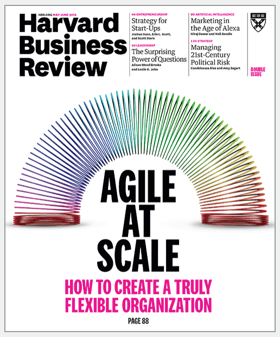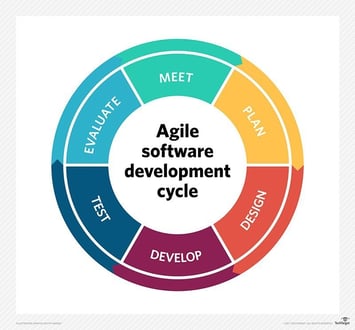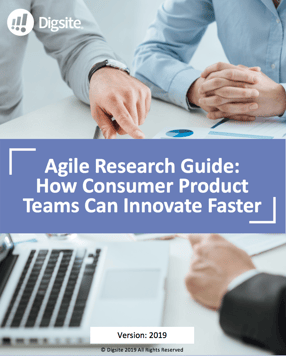Getting your business to the next level starts with agile research. This approach enables you to design, build and iterate better products and services quickly and deliver the best customer experiences possible in every interaction.
Main Points:
- Success in today’s competitive and complex business landscape starts with moving quickly
- If you’re unable to iterate fast—or you're basing your decisions on your gut alone—it will be much more difficult to succeed
- By adopting an agile approach and leveraging agile qualitative research, your organization is able to continuously iterate, developing and optimizing products and services that deliver the best customer experiences every time
The pace of our industry—marketing and product development—is accelerating.
Contrary to what the headlines might suggest, this change isn’t exclusively because of automation or machine learning—technologies which are certainly transforming the way we work. It's also due to the rise of new solutions that enable organizations to tap continuous in-context engagement and learning to make better decisions.
In fact, the timeliness of this issue—and opportunity—is demonstrated front-and-center as it appeared on the cover of this month's Harvard Business Review.
 [source: https://hbr.org/magazine]
[source: https://hbr.org/magazine]
When trying to make a decision organizations have tapped into surveys or other tracking studies to identify problems or gaps. But, to understand the "why"s and build solutions, they’d generally assemble in-person interviews or focus groups. Not only is that approach expensive, it’s also incredibly time-consuming.
Thanks to the evolution of technology, there are many new ways to measure the customer experience today. Companies have increased the sophistication of analyzing text responses from customer satisfaction surveys (which have been around forever). They can also collect more in-depth behavioral data from several sources (e.g., contact centers, websites, apps, and online transactions).
Just because you’re able to generate data, however, doesn’t mean that data will produce better results. In order to make the best decisions, you need to get the right data from the right people at the right time.
To compete—and innovate effectively—you need to figure out everything you can do to improve customer experiences. You also need to learn how to build new solutions as quickly as you can.
To do that, you need to become agile, leveraging agile research that looks beyond the past to speed up the process of building solutions.
The good news is that isn’t as difficult as it might sound.
Thanks to innovative new platforms it’s easier, faster and more affordable than ever for companies to gather the qualitative "why" data they need to build new solutions and optimize customer experiences. Here at Digsite we provide companies with agile insights they can leverage to build and iterate the best customer experiences.
But What are Agile Insights?
Agile insights are part of the agile development process of learning and iterating in quick “sprints” that can be wrapped up in a day or less—or extended over the course of a week or more—depending on the needs of your organization.
Research participants that are highly targeted to match the experience you are optimizing are able to easily and quickly provide feedback, which you can then leverage to refine your offerings, using data to ensure the changes you make align with customer expectations.
Thanks to agile insights, you can design, build and test simultaneously—rather than sequentially. This enables you to release better solutions in less time and with fewer resources.
Success in today’s tricky environment is not about analyzing more and more data faster and faster. Rather, it’s about analyzing the right data—and the context around it—to create stories and designs that change people’s minds and influence their decisions.
Agile is a way of thinking. It’s a philosophy. It’s all about learning in context, building solutions and optimizing as you move forward.

[source: https://searchsoftwarequality.techtarget.com/definition/agile-software-development]
Understanding the Why
Let’s say you’re conducting an A/B email test to see which subject line is best and Subject B gets more engagement. Instead of simply saying Subject B is better, you need to figure out why it’s better so you can repeat its success in the future—and get even better results.
In other words, it’s less about the quantity of the data—and more about the quality of the data.
When you understand the context of choices and experiences, you’re able to make better decisions. Learn what was happening outside of the actual product that impacted customer experiences and use that information to deliver stronger ones.
We’re all social creatures who are influenced by each other. Tap your foot the next time you’re at the airport and—before you know it—someone nearby will start tapping their foot, too.
To understand why customers experience products, services and campaigns the way they do, you need to first understand the context they’re operating in.
This is where agile insights are particularly helpful. By putting a group of participants together in a social digital environment, you can see how various people perceive your products and campaigns—and how those folks are influenced by the other peers in the group.
How Do You Get Started?
No two organizations are the same. In order to revamp your company’s approach to embed agile research, you’re going to have to come up with a plan that makes sense for your unique situation.
First things first: Talk to your stakeholders about their need for faster development of new or improved products and services. Evaluate the gaps in your current research vs. what you would need to have multiple customer engagements/iterations as you build solutions.
When making the switch to agile research, start small. Experiment with a single initiative, breaking it down into a series of sprints and learn from your experiences. Diagnose the issues as you move forward and build new solutions by changing what isn’t working.
-1.png?width=355&height=292&name=Humorous%20Pizza%20Lovers'%20Endearment%20Facebook%20Post%20(1)-1.png)
Switching to agile research requires a cultural shift. You can’t just have one person cheerlead the cause and expect everyone else to enthusiastically follow suit.
For the best results, figure out a way to get all a group of cross-functional stakeholders involved from the outset. This can be challenging because people are comfortable doing what they know how to do. Many don’t like trying new things and are fearful of change. Others might get concerned that a faster approach to research and product development might result in a compromise in quality.
To get everyone on board, focus on the how agile research can enable your organization to build better customer experiences faster by getting higher quality insights as you build solutions.
As you begin your shift to agile research:
- Conduct a SWOT analysis of your current research methods to determine the gaps in understanding context and getting quick insights as you iterate as you build solutions. This enables you to make the business case for bringing in new agile research solutions.
- Identify and leverage new methods and technologies that enable you to get agile insights (e.g., Digsite). Look for qualitative solutions that are not only fast, but make your job easier so you can focus on driving fast team decisions.
- Surround yourself with a talented and diverse team. Find advocates across your company: tap cross-functional decision makers including market research, user experience, marketing, and R&D. The more evangelists you’re able to create, the easier it will be to get results.
When you’re ready, move forward with a pilot initiative using your new agile approach. Once you’re ready to showcase your results, the rest of the organization will buy in.
Not All Data is the Same.
In the age of big data, it’s easy for organizations to get carried away, tracking metrics that don’t really matter.
In the world of insights, there’s data that helps you identify existing problems and opportunities. But there’s also data that helps you build and optimize new solutions.
Truly transformational insights can be generated through agile research. And agile approach, after all, is all about solving problems—not just defining them.
To succeed in the future, you need to do more than collect user experience data. You need to understand they why, iterate as you learn, get additional feedback and context and continue to optimize your products and campaigns.
There’s no sense in taking shots in the dark when you don’t have to. By leveraging a leading agile research platform like Digsite, you won’t have to.
The end result? Spectacular customer experiences—and a stronger bottom line.
Ready to learn more or get started? Download our free ebook, Agile Research Guide: How Consumer Product Teams Can Innovate Faster.






